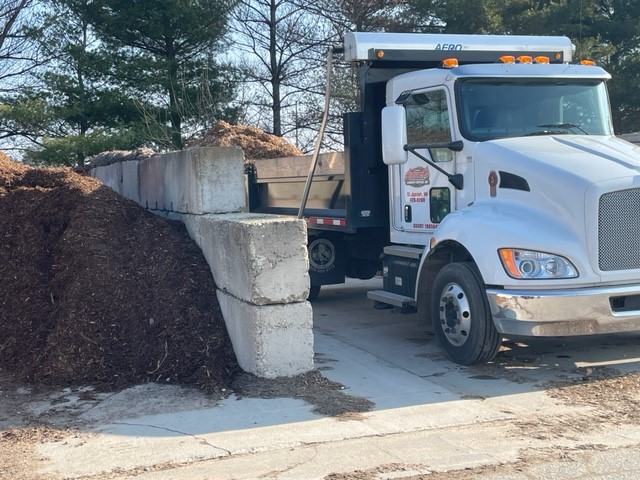Have questions?
Ask the Experts
At Adent’s Landscape Supplies Inc, we’ve made it our priority to provide the best landscaping products at reasonable prices. Whether you need organic topsoil, native riverstone, mulch, or flagstone, we have the landscaping materials you need to get the job done. Our friendly and knowledgeable team is happy to answer any questions you have about our products and how they fit into your project.
Below is a few common questions we receive. For more information about how we can help you, please contact us at 269-428-0200 or see our Estimate Calculator.

(Length in feet X Width in feet X Depth in inches) / 324 = Cubic Yards
To determine the amount of bulk material you will need, you first need to know the square feet of the area you are going to cover:
Length times Width = Square Feet
For example: 10 ft. X 15 ft. = 150 sq. ft.
Next, determine your depth in inches. Multiply your total square feet by this depth, then divide this number by 324 to convert to cubic yards.
For example: 150 sq. ft. X 4 in. = 600; (600)/(324) = 1.85 cubic yards
It depends on whether they are new beds or if there is existing mulch. For new beds, 4 inches is acceptable. If you are top dressing additional mulch, 2 inches would be a considerate amount.
Other than the fact that you are getting 6,000 lbs of stone, not much. Weight is not a measurement that can be used to figure volume. All stone does not weigh the same, but volume is the same for all products. The industry standard for most river stone, sand and gravel is between 1.35 and 1.50 tons per cubic yard. To convert tons to yards, find out how much the stone weighs per yard, and divide that by 2000. This will give you your factor. Divide the number of tons you are getting by this factor, and that will roughly be the number of yards of stone you will receive.
For example: (1 yard weighing 2700 lbs) / (2000) = 1.35 factor
3 tons / 1.35 = 2.22 cubic yards of stone
To be fair, neither. It all depends on the application! If your landscaping beds have a lot of flowering shrubs and annuals, then bark mulch is probably your best bet. If you have evergreens and woody ornamentals, you may get away with using stone. Bark mulch is going to hold more moisture for your plants and keep the soil temperatures more consistent, whereas stone will tend to get hotter and reflect that heat onto your plants.
Using the same formula as above, break the area into smaller sections to create squared areas.
Pavers, Compost, Flagstone in St. Joseph, MI
Section 1 – Use the formula for the area of a circle (3.14 X Radius X Radius). Since our example is only half of a circle, this answer would be divided by 2. Section 1 has a diameter of 8 feet, and since the radius of a circle is the diameter divided by 2 (where 8 ft. / 2 = 4 ft.), the calculation would be:
3.14 X 4 ft. X 4 ft. = 50.24 sq. ft. for a full circle
divided by 2 = 25.12 sq. ft. for a half circle
Section 2 – Since it is a simple square, all we need to do is multiply the length times the width:
10 ft. X 4 ft. = 40 sq. ft.
Section 3 – Although this is not exactly a square area, it is better to have too much supply than not enough. Therefore, the same equation is used as in section 2:
25 ft. X 15 ft. = 375 sq. ft.
Finally, add these three sections together, multiply by how many inches thick you want it, and divide this answer by 324.
25.12 + 40 + 375 = 440.12; 440.12 X 4 in. = 1760.48;
1760.48 / 324 = 5.43 cubic yards
Note: It is always better to have 1/2 to 3/4 yards too much than to be short on supplies.
